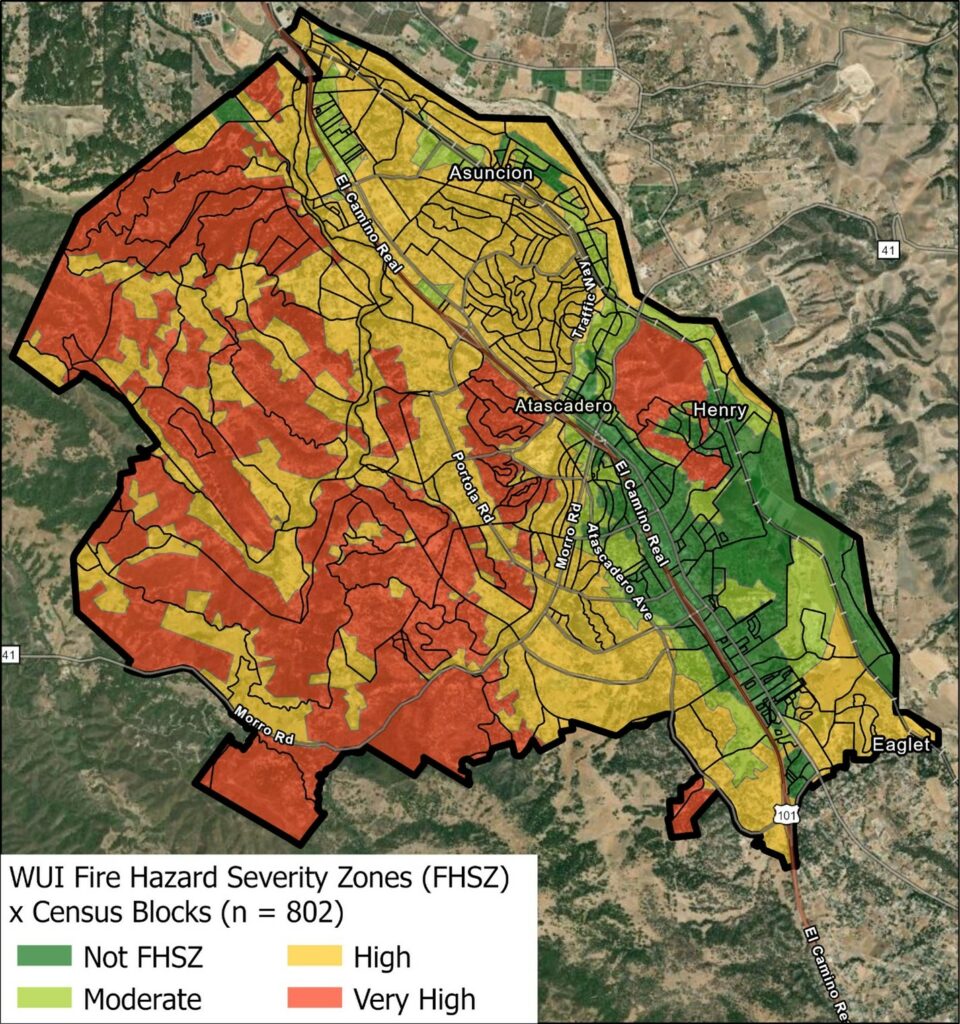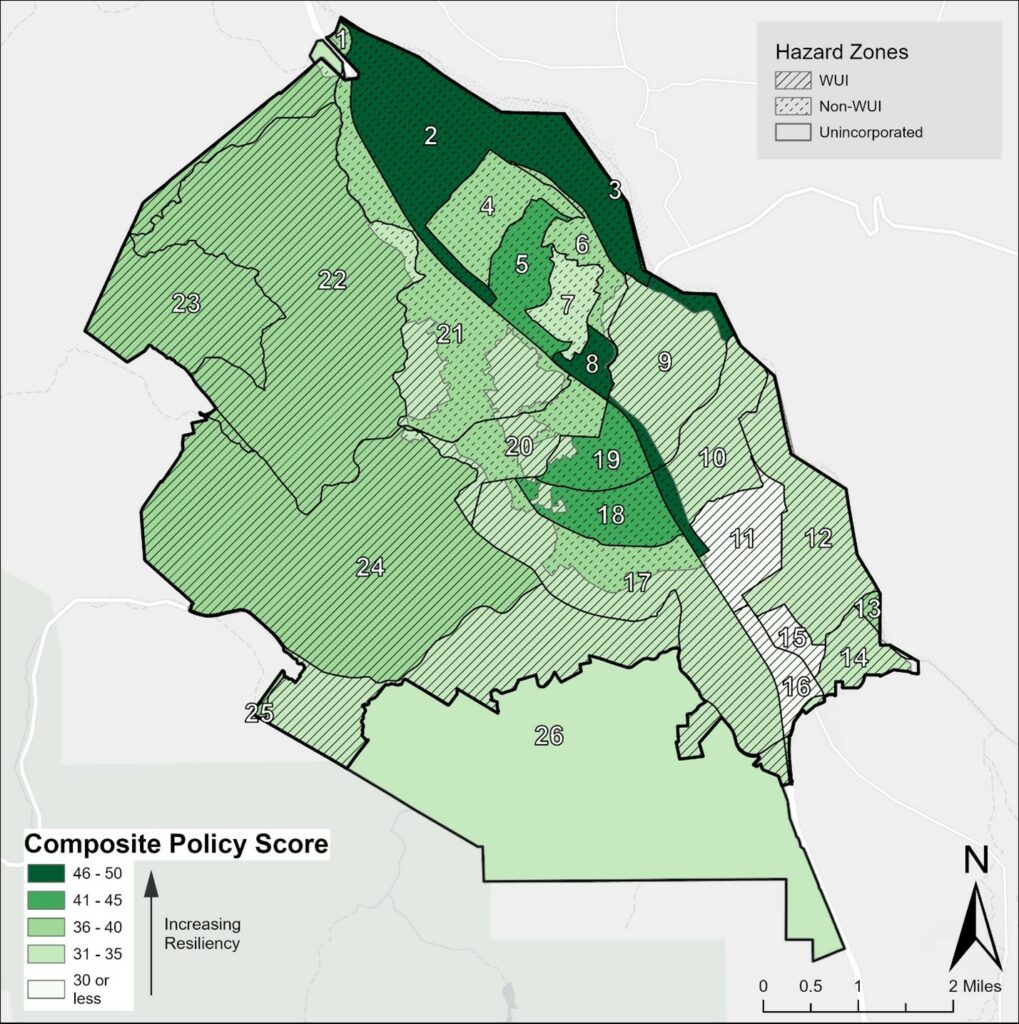Spatially Evaluating Networks of Plans to Reduce Wildfire Vulnerability
By Dr. William Siembieda, AICP, Cal Poly SLO and Dr. Matt Malecha, Texas A&M University
Seven of the ten most destructive fires in California have occurred in the last five years, and one in four Californians lives in an area considered high-risk for wildfires. These hazards can be addressed by focusing on local planning and land use decisions that are guided by a community’s “network of plans.”
Better Planning for Wildfire Hazards
Increasingly, communities in California and across the U.S. are facing an ever-expanding “network of plans” (e.g., General (Comprehensive) Plan, Hazard Mitigation Plan, Community Wildfire Protection Plan, Climate Action Plan, and various sectoral or area plans). These plans are frequently poorly integrated and may, in fact, exacerbate vulnerabilities, including the risk of wildfire, especially in the wildland urban interface (WUI).

The Plan Integration for Resilience Scorecard™ (PIRS™) for Wildfire tool seeks to break down silos and improve communication between planning, fire, and emergency management departments by providing a framework for linking land use planning and hazard policy using a process of spatial plan evaluation. It has been used for flooding and is now being expanded to address wildfire hazards to achieve plan alignment and integration. This tool aims to harmonize the guidance provided by their networks of plans, assessing their plans spatially and through the lens of wildfire risk reduction to facilitate adjustments that improve coordination and strengthen wildfire resilience in the most vulnerable locations. This is an adaptive methodology being run by experienced planning and wildfire professionals and academics from California Polytechnic State University San Luis Obispo’s Wildland Urban Interface Fire Institute, and Texas A&M University’s Hazard Reduction and Recovery Center. This is a no-cost city/county initiative, where professionals will assist and guide municipalities and communities through every step of the process to improve wildfire resilience and hazard mitigation.
The Benefits of PIRS™ for Wildfire
California cities and counties often have an array of plans that guide their growth and management—typically including a General Plan, a Hazard Mitigation Plan, a Community Wildfire Protection Plan, and possibly many others. Aligning these various plans so that they work together to effectively reduce hazard vulnerability can be a big challenge. PIRS™ for Wildfire offers communities a systematic way to evaluate their existing policies and to align and integrate them to reduce wildfire risk and mitigate wildfire impact. It builds on a community’s ongoing planning efforts, helping to improve staff communication, incorporate diverse and valuable knowledge and perspectives (from planning, fire safety, emergency management and other relevant personnel), and reduce duplication of efforts and potential conflicts. It has been shown to be especially valuable if used during plan development or plan update processes.

The PIRS™ for Wildfire Process
The PIRS™ for Wildfire process involves the following steps:
- Delineate “district-hazard zones”
- To enable spatial plan and policy evaluation, the community is first subdivided into relevant planning districts (e.g., neighborhoods, U.S. Census block groups) and hazard zones (e.g., Fire Hazard Severity Zones). These are combined using GIS to form a layer of mutually exclusive “district-hazard zones,” the spatial unit of analysis for a PIRS™ for Wildfire evaluation.
- Review the community’s network of plans
- The community’s network of plans (e.g., General Plans, Hazard Mitigation Plans, Climate Action Plans) is then closely reviewed for actionable policy statements that are likely to affect wildfire resilience, either positively or negatively, and that contain some sort of place-specific term that helps identify where they apply (and where they do not). Relevant policies are added to the scorecard.
- Evaluate plans spatially
- Each policy is then given a score of “+1” (increases wildfire resilience), “-1” (decreases resilience), or “0” (neutral) and assigned to the appropriate district-hazard zone(s) based on its place-specific term. This is repeated for all relevant policies across the community’s entire network of plans. Scores are then summed for each district-hazard zone.
- Assess other vulnerabilities (optional)
- Social, physical, or other types of vulnerabilities can also be spatially assessed and compared to the spatial plan evaluation. The location of critical facilities or evacuation routes, for example, may also be considered.
- Analyze results
- Tables and maps help identify spatial patterns, synergies, conflicts, and gaps in the community’s network of plans and policies and how they may affect wildfire risk and wildfire spread
- Advance plan integration and wildfire resilience
- Guided by the spatial and hazard-focused PIRS™ for Wildfire analysis, community plans can then be improved by adjusting or adding policies (e.g., clustering development in the WUI) to resolve identified conflicts and strengthen wildfire resilience.
Preliminary Findings
Early results suggest that the PIRS™ for Wildfire method is an effective tool in the wildfire context. Our past community partners have engaged with and learned from the process. The new perspective and data have helped communities better understand the effects of their plans and policies related to wildfire risk. The focus on hazards and the spatial framework revealed patterns of policies that support wildfire resilience, “hot spots” of policy conflict, and “cool spots” with limited policy attention. Vulnerability assessments have provided additional insight into areas of need in the communities. The fuel path disturbance conceptual approach (i.e., fire spread structure-to-structure, structure-to-vegetation, and vegetation-to-vegetation) is one of the frameworks being developed as part of the PIRS™ for Wildfire toolkit.
Next Steps
The PIRS™ team will continue to encourage municipalities to use the PIRS™ for Wildfire method to guide their general plan update processes (and network of plans updates) to strengthen integration and wildfire resilience. This free support and policy auditing will help communities expand their policy-making capabilities to meet their planning goals and explore the potential of “nested” PIRS™ for Wildfire evaluations at multiple scales. This process will also advise communities on how to use the perspective, knowledge, and empirical data gained through the PIRS™ for Wildfire process when applying for federal and state wildfire mitigation grants. The team is developing a PIRS™ for Wildfire Guidebook, based on these initial applications and community collaborations. The PIRS™ team is seeking interested cities and counties to partner with to improve wildfire resilience, especially in communities that have a high portion of land within the Wildland Urban Interface (WUI). For more information on PIRS™ and plan integration, visit the link www.planintegration.com or contact the team leads: Dr. William Siembieda, AICP, Cal Poly SLO (wsiembie@calpoly.edu) and Dr. Matt Malecha, Texas A&M University (mmalecha@arch.tamu.edu).
